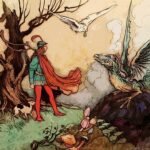What if swallowing a simple rose leaf could alter your destiny forever?
In our latest Tales of Bedlam episode, your hosts Knob Twister and Sofa Sitter dive into one of fairy tale literature’s most chilling yet overlooked gems: “The Young Slave” by Giambattista Basile. This haunting tale from the 1600s predates many of our beloved fairy tales—and may have secretly inspired them.

A Forgotten Tale That Haunts
Long before the Brothers Grimm collected their stories, Basile was documenting tales that would become the foundation of European fairy tale tradition. His collection Il Pentamerone (published in 1634-1636) contains the earliest literary versions of classics like “Cinderella,” “Rapunzel,” and “Sleeping Beauty.”
Yet “The Young Slave” remains relatively unknown to modern audiences despite containing elements that would later become fairy tale staples.
The story follows Lisa, a girl cursed by a fairy, who falls into a death-like sleep when a rose leaf becomes lodged in her hair. Her grieving uncle places her in seven crystal coffins, and she grows into a beautiful young woman while appearing dead.
Years later, her uncle’s jealous wife discovers Lisa alive and reduces her to slavery, subjecting her to terrible cruelty—until Lisa’s salvation comes through an unexpected source.
The Reimagined Ending
In our Tales of Bedlam episode, we shared Knob Twister’s reimagined conclusion to this haunting narrative:
Then he sharpened the knife upon the pumice stone and gave it to Lisa’s little doll. To the amazement of those attending the feast, the doll drew breath and hefted the knife with both hands. Proceeding to stab repeatedly at the fine breast of the Baron’s wife.
Time and time again, the knife cleaved deep into her chest till her heart sprung forth in a crimson fountain. Speckling the now horrified onlookers with the hot blood.
Blood rot with jealousy and hatred. The little doll once more drew breath and cried, “Can you hear me now bitch!”
This dramatically violent reimagining captures the unexpected vengeance theme that appears frequently in older fairy tale traditions—a sharp contrast to the sanitized versions we often encounter today.
While certainly a departure from Basile’s original ending (where the uncle murders his wife after discovering her cruelty), this creative adaptation highlights the tale’s underlying themes of justice and retribution.
The Fairy Tale DNA: Connections to Stories We Know
What makes “The Young Slave” particularly fascinating is how it contains elements that would later appear in numerous well-known fairy tales:
🔒 The Forbidden Room
Like Bluebeard’s chamber of horrors, the seven crystal coffins containing Lisa represent forbidden knowledge and the consequences of curiosity. Women in these tales are repeatedly punished for their inquisitiveness—a troubling theme that reveals historical attitudes toward female autonomy.
💤 The Sleeping Curse
Lisa’s enchanted sleep predates “Sleeping Beauty” by decades. Rather than a spindle, a comb stuck in her hair causes her suspended animation—highlighting how these tales evolve while maintaining their core motifs.
🎁 The Symbolic Gifts
When Lisa’s uncle asked what she wanted from his travels, she requested “a doll, a knife, and a pumice stone.” This pattern of three magical objects mirrors similar requests in Beauty and the Beast and countless other tales, where seemingly ordinary items become instruments of salvation.
🗣️ The Speaking Object
Lisa confides in her doll, speaking to it about her suffering. This communion with an inanimate object that later helps save her recalls the helping horse in “The Goose Girl”—both tales suggest that when human allies fail, magic steps in.
⚰️ The Crystal Coffin
Seven caskets rather than seven dwarfs, a comb rather than an apple—”The Young Slave” shares striking similarities with “Snow White,” reinforcing how these narrative elements have persisted through centuries of storytelling.
The Unsettling Moral
Basile concludes with the proverb, “Heaven rains favor on us when we least expect it,” a sentiment that seems almost absurdly insufficient given Lisa’s suffering. This disconnect between terrible circumstances and simplistic morals is characteristic of many early fairy tales, which often dealt with brutal realities while offering thin consolations.
The tale refuses to provide a neatly packaged lesson. Instead, it presents a world where cruelty exists alongside magic, suffering may be prolonged, and justice—when it finally arrives—is often severe and bloody.
The Man Behind the Tales
Giambattista Basile (February 1566 – February 1632) lived as colorful as his stories. As an Italian poet, courtier, and collector of folk tales, he traveled extensively throughout Italy, gathering stories that had previously existed only in oral tradition.
His masterwork, Il Pentamerone (also known as The Tale of Tales), was revolutionary in using vernacular Neapolitan dialect rather than formal Italian, preserving the stories and the linguistic character of their telling. This collection contains the oldest written versions of many European fairy tales, making Basile a foundational figure in fairy tale literature whose influence rivals that of the more famous Grimm brothers.
Why These Forgotten Tales Matter
Tales like “The Young Slave” remind us that fairy tales weren’t originally bedtime stories for children. They were complex narratives that addressed adult fears, desires, and social realities—often with violence and sexuality intact.
By exploring these original versions, we gain insight into the consistency of human storytelling (how specific motifs persist across cultures and centuries) and the evolution of these stories as they’ve been adapted to reflect changing social values.
The enduring power of “The Young Slave” lies not in its happy ending or simple moral but in its unflinching portrayal of cruelty, beauty, and unexpected salvation—themes that continue to resonate across the centuries.
Have you encountered other forgotten fairy tales that deserve more attention? Do you prefer these stories’ original, darker versions or modernized adaptations?
Share your thoughts in the comments below, and don’t forget to subscribe to Tales of Bedlam for more explorations of the fascinating world of folklore and fairy tales!


